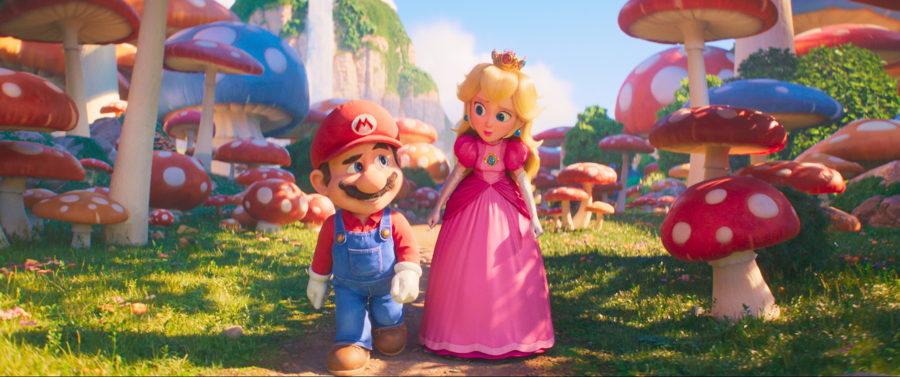Spoiler-free review: ‘The Super Mario Bros. Movie’ is a love letter to long-time fans of the mustachioed plumbers
Mario (voiced by Chris Pratt), left, and Princess Peach (voiced by Anya Taylor-Joy) in “The Super Mario Bros. Movie.” (Nintendo, Illumination Entertainment and Universal Pictures/TNS)
Apr 7, 2023
Universal Pictures’ “The Super Mario Bros. Movie” is filled with plenty of nods and callbacks of the long lasting franchise, revolving around the two brothers: Mario and Luigi.
Fans on Twitter were quick to critique some of the film’s casting choices while praising others. They questioned how Chris Pratt could possibly be the iconic plumber, while castings like Charlie Day as Luigi were praised.
Despite the controversial roster, I believe the cast fit the characters perfectly without relying on the Brooklyn accents and stereotypes. Peach is also not as high-pitched as she is portrayed in the video games, instead commanding authority from the confidence Anya Taylor-Joy exudes.
Bowser, voiced by Jack Black, is perhaps the most striking. Black showcases his musical talents as the ferocious Bowser, breaking out into a song about Princess Peach. However, Bowser is not as intimidating in the film as he has been in the games, being portrayed as more human with flustered emotions.
Toad, voiced by Keegan Michael-Key, is an enjoyable character. He often calls Mario his “best friend” and has qualities in the film that are goofy, and almost uncharacteristic of other Mushroom Kingdom citizens. For example, he’s driving a souped-up racing cart and randomly cooks a meal for other toads as a form of distraction.
The casting for this movie started to make sense when it came to giving the characters personalities during tense moments. It’s too often we hear Mario in the games go “mama mia!” or “wahoo!,” but what does the mustachioed plumber really think when faced with conflict? Pratt executes this perfectly by giving life to Mario in his lowest state.
The film pays homage to many of the different titles Mario has appeared in, reestablishing the rivalry between him and Donkey Kong as seen in the 1981 video game.
Donkey Kong, voiced by Seth Rogan, takes a jock personality type, but becomes fitting of the character as Donkey Kong becomes more involved in the story. He supports Mario, but makes it clear that they are still enemies to some degree.
For Princess Peach, voiced by Taylor-Joy, she ditched the usual role of the princess being a damsel in distress, instead taking a more prominent role like in the “Super Princess Peach” game. Peach is now aiding Mario in a leading role with the help of Toad to defend the Mushroom Kingdom.
The movie also pays tribute to both the often forgotten origins of the Mario brothers, reestablishing the two living in Brooklyn, first established in the live-action/animated TV show “The Super Mario Bros. Super Show!”
They remind the audience that two brothers work as plumbers, having a van and a commercial dedicated to their businesses outside of the Mushroom Kingdom.
In the film, we also get glimpses of small easter eggs, some more noticeable than others. One of the first easter eggs the audience gets exposed to is Foreman Spike, played by Sebastian Maniscalco and the antagonist of one Super Mario entry, “Wrecking Crew.” He’s just as much of an antagonist in the film as he is in the game.
To much of the audience’s surprise, the film showcases the extended family of the Mario brothers, with Mario’s dad being voiced by the original voice actor from the video games, Charles Martinet.
The film follows the brothers for only a short time in the beginning before the two are separated; Mario is transported to the Mushroom Kingdom following the premise of most of his game titles, while Luigi gets the bad end of the stick reminiscent of his solo titles, “Luigi’s Mansion 1, 2, and 3.”
The soundtrack is based on the ‘80s, coinciding with when the “Super Mario” games first debuted. Songs like A-Ha’s “Take On Me” and Bonnie Tyler’s “Holdin’ Out For A Hero” provide color to the sequences in which characters take on challenges in the film. Original melodies from the games are reworked to accompany characters throughout prominent moments paralleled to the games.
One of the main challenges Mario faces is the feeling of self-doubt pressured by Foreman Spike, his parents and a bit from Donkey Kong. He’s repeatedly mocked for his height or his aspirations, and in the film when he trains himself to get better, we see a more human ambition fueled by his desire to save his brother.
Audiences should be prepared to forget about Luigi for a bit. The film revolves around bonding, yet Luigi is absent and cast aside for a long time in the film. In his situation, it might have been hard to advance the story, but perhaps the writers could have expanded more upon Luigi’s frightful adventures. He’s not as cowardly as the movie makes him seem.
The film is an excellent depiction of the bond between siblings rather than the repetitive “save the princess” plot. Much like the premise of the first installment of “Luigi’s Mansion,” we’re now following Mario rescuing his beloved brother rather than a woman he just met.
Overall, “The Super Mario Bros. Movie” is an enjoyable watch to both long-time fans of the franchise and casual viewers alike. The story is easy to follow and does not forget to showcase the color and beauty that captured the hearts of those growing up with the characters.








